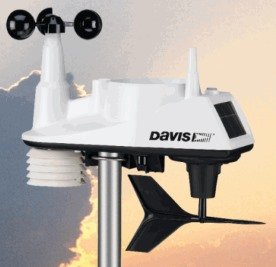Davis 6250 Vantage Vue stations were marketed as good-quality, entry-level weather stations, but clearly signposted as non-expandable. The lack of options to add extra sensors to a Vue is one of the key benefits from upgrading to a Vantage Pro 2 (VP2) station over the 6250 Vue.
That said, established Vue owners still often look for ways to expand their systems without buying a complete replacement VP2 station. This topic lists a few options by which a Vue station can actually be expanded. To be clear, other than the options below there is no way of adding supplementary temperature (or humidity) or soil moisture, leaf wetness etc sensors to a Vue. These options typically involve buying some extra sensors and wireless transmitters and so inevitably there is some significant cost involved. But for anyone who is interested in Vue add-ons here are the options:
Anemometer transmitter
The one sensor expansion option that a standard Vue allows is to add a separate 6410 VP2 anemometer and its 6332 wireless transmitter (6332 used to be called the anemometer transmitter but as of 2019 exactly the same part has been renamed as the ‘Solar-powered wireless sensor transmitter’). With this option the signal from the Vue’s built-in anemometer parts is replaced by the signal from the 6332 transmitter, ie the Vue console can receive wind data from only one transmitter. Note that while the anemometer transmitter has inputs for other sensors such as temp/hum, rain and solar/UV, no readings from these other sensors can be received by the Vue console (unless the console is switched to using the anemometer transmitter as its only ISS, in place of the main Vue ISS).
Options to add Solar and/or UV sensors to a Vue installation
Solar and/or UV sensors cannot be added directly to a Vue installation. However, there are a few ways in which data from solar/UV sensors can be incorporated into the overall data stream from a Vue:
Switch to a VP2 Plus ISS
While solar/UV cannot be added to a Vue ISS, the Vue console can display data from solar/UV sensors. To achieve this the Vue ISS must be replaced by a VP2 Plus ISS (or standard VP2 ISS fitted with a solar sensor). A data logger fitted to the Vue console will be able to log and feed the solar/UV data just as if it were fitted to a VP2 console.
Add a Weatherlink Live receiver or 6313 Weatherlink console unit
The 6100 Weatherlink Live (WLL) unit is capable of receiving data from up to eight different VP2-type wireless sensor transmitters and uploading them to the Davis weatherlink.com cloud platform. So any existing Vue ISS could be one of the eight transmitters while solar/UV sensors attached to a 6332 sensor transmitter could be a second one. Adding Weatherlink Live plus solar/UV sensors and transmitter is not a specially cheap option but once the 6100 WLL has been installed then it opens up the way to considerable further expansion, if required.
It’s worth underlining that the main way by which all data is expected to be viewed from Weatherlink Live is via the weatherlink.com web interface – any solar/UV readings will not appear on the Vue console screen. Nonetheless this is a mechanism by which solar/UV readings could be added to a Vue installation when the data is accessed via weatherlink.com. (NB There are other local data features due to be added to Weatherlink Live, but these haven’t been fully disclosed yet.)
The 6313 console is fully compatible with receiving data from a 6357 Vue ISS.
Add a Meteobridge Pro unit
Meteobridge Pro Red (see our main website for further details) provides data handling services that are comparable in principle to the Weatherlink Live unit above, eg 8-transmitter reception allowing a separate 6332 transmitter + solar/UV sensors to be added as outlined above. However, the data handling for this Pro Red option is fully local and substantially more flexible than WLL. The MB Pro Red unit also has the advantage of being available now.




Post your comment on this topic.